AMPLIFY VOL. 36, NO. 12

The authors cover the strategic impact of character development in the public and private sectors. They advocate a shift from mere awareness to integrating character development into organizational practices, with an emphasis on the interconnected nature of character dimensions. Introducing the Virtuosity mobile app as a practical tool for character development, the authors propose a strategic embedding process model for sustained change. They highlight the crucial relationship between individual and organizational systems and emphasize the need for alignment. The article concludes with a call to action, asserting that the tools and understanding necessary for achieving lasting impact are readily available.
A day doesn’t go by in which we don’t talk about [leader character] in some way or another.
— John Ossowski, President, CBSA1
The strategic impact of leader character has the potential to improve any initiative within an organization from performance and culture to well-being and diversity, equity, and inclusion (DEI). Ossowski was an early adopter of character leadership, embedding it throughout the Canada Border Services Agency (CBSA) with the belief it would fundamentally impact the organization and the lives of those in it. As he points out, it manifests each day in conversations, decisions, and actions.
This article provides a strategic roadmap to help individuals and organizations understand, develop, and embed leader character into organizations. We draw attention to the intricate relationship between individuals and the systems needed to support meaningful, lasting character development. We also discuss Virtuosity, an app that can support individual character development across an organization. Research shows that those with access to systems conducive to character development experience greater character change, leading to increased performance and stronger relationships.2
The Case for Character
Building on the shoulders of philosophers Confucius, Aristotle, and Plato and modern-day psychologists such as Martin Seligman, researchers developed a robust framework that we use as a starting point (see Figure 1).3 The framework has been extensively peer reviewed, so organizations can be confident they are on solid theoretical and empirical ground. This foundation has yielded a set of resources and approaches that are practical and pragmatic and are being used across a variety of sectors and industries.
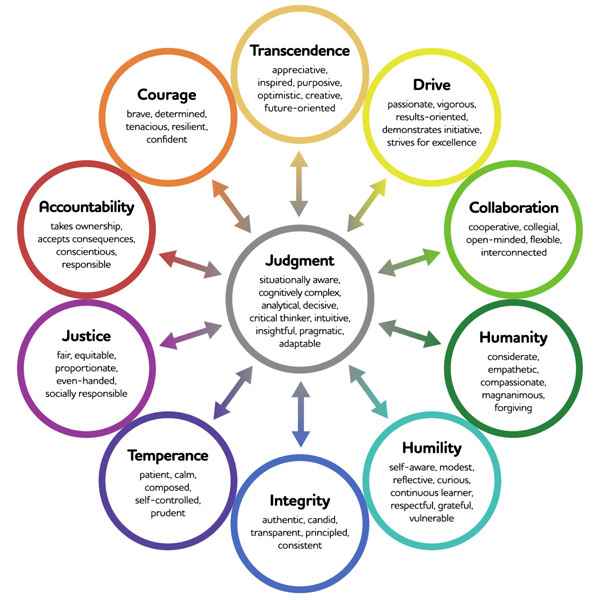
The framework addresses key shortcomings in the everyday understanding of character. Most people think character is about morals and ethics, is nice to have but impedes performance, and/or is subjective and can’t be developed. The framework shows that character is centered around judgment, which underpins performance and well-being, and because it is clearly defined through a set of behaviors, it can be objectively assessed and intentionally developed.
In the framework, we see that all character dimensions are interconnected and all inform judgment. Because of their interconnected nature, high levels of any dimension not strongly supported by others could manifest from a virtue into a vice. For example, even if someone is authentic, candid, transparent, principled, and consistent, strong integrity can become uncompromising, belligerent, rigid, dogmatic, and indiscriminate when not supported by humility and humanity.
Prior research of existing data sets and ongoing research projects at the Ivey Business School found an extensive list of benefits associated with those of strong character, including:4,5
-
14% increase in leader effectiveness
-
10% increase in leader resilience
-
8% increase in leader well-being
-
6% increase in promotion potential
-
18% increase in employee voice
-
16% improvement in psychological safety
-
8% increase in organizational commitment
-
8% increase in work engagement
-
4% increase in subjective well-being
-
10% increase in job-related well-being
-
10% increase in job satisfaction
Leader Character Impact Vectors
In general, people understand what character is and why it matters but not what it takes to cultivate the habits associated with character. Without this understanding, efforts to elevate character to achieve competitive advantage at either the individual or organizational level will be compromised.
By competitive advantage, we mean that whether you are a for-profit or not-for-profit, you need to compete for time, attention, and engagement. Furthermore, the need to thrive amidst the challenges and complexities means that you have to deliver on the demands of today while simultaneously building for the future. This requires strength of character. Additionally, for character to reach its full strategic impact, it must be embedded and institutionalized across the organization.
Figure 2 shows three vectors for reaching strategic impact. Whether it be leadership development in general or leader character specifically, there is a risk of a Temporary Bump: character education is provided, but we don’t see the type of sustainable change that leads to a sustainable competitive advantage.
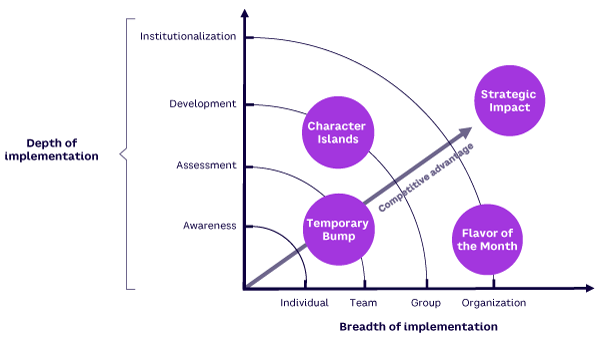
There are two other vectors. One is the depth of implementation that moves through awareness-assessment-development-institutionalization (vertical axis) within a small group or team to establish what we call Character Islands (spaces where character resides but are detached from other parts of the organization).
Character Islands are a good start, but institutionalization usually depends on broader implementations in which the entire organization embraces leader character to achieve strategic impact. The other vector is breadth of implementation, which involves scaling awareness by running seminars and workshops across the organization (horizontal axis). This approach runs the risk of creating a Flavor of the Month if there is no plan to permanently embed character into the organization.
The Temporary Bump: Individual Awareness & Assessment
Fostering individual awareness of leader character is incredibly important. There is foundational work to be done to help individuals understand the anatomy of character and how virtues can operate as vices, laying the groundwork for development and paving the way for embedding and institutionalizing character in organizations. It’s critical to enable individual awareness of the awesome power that character has to transform their lives, both personally and professionally. This creates the motivation for individuals to invest in their own character development.
When I think of pivotal, life-changing experiences … that have the potential to define who I am, what I want to do, and who I aspire to be, undertaking this training program has been the most important thing that I can remember in my adult life. It is reshaping many areas of my life and has changed my entire perspective whilst giving me a new sense of purpose.
— Anonymous quote from an executive engaging in a leader character development practitioner program
Although workshops are the predominant means to foster awareness, there are other resources and tools, including the Question of Character podcast, with initial episodes that expose listeners to core ideas about leader character development.6 Books such as Developing Leadership Character and The Character Compass foster awareness, not just of what leader character is and why it matters, but also what the road to strategic impact looks like.7,8 The Leader Character Insight Assessment (LCIA) in both self-assessment and 360-assessment provide a useful snapshot of individual character.9
Initial workshops help participants develop a common language around an area fraught with misconception. These misconceptions usually involve overemphasizing some dimensions of character and underemphasizing others, leading to organizational dysfunction. Not surprisingly, having such workshops at senior levels is particularly important. Because participants typically grasp both the blind spots in their own character and the paradigm shift that will serve them personally and professionally, the workshops provide essential motivation for moving past what might otherwise be just a temporary bump.
Depth: Scaled & Customized Daily Practice
We’ve seen many workshops where participants leave feeling inspired but little change follows because participants are not equipped with the tools they need to enact change. Character development occurs through habituated practice that requires daily exercise. Similar to a muscle, it requires consistent practice for it to strengthen.
The process of character development is similar to athletic performance training and draws on many of these techniques. Just as spending an hour in the gym improves a range of outcomes, from the quality of one’s conversations to sleep, people who invest a few minutes in the Virtuosity app are primed to engage in their day more fully. For example, someone focusing on developing their open-mindedness might be offered a daily challenge of using “yes, and” language in one or two conversations during the day.
Failing to sufficiently customize learning and development programs can lead to wasted effort, frustration, and unintended consequences. For example, we saw the healthcare industry shift its focus to compassionate leadership, but this led many people to burnout because over-weighting their compassion meant they neglected the integrity and temperance needed to set healthy boundaries.
A customized program is critical to allow each individual to attend to their own character needs, so they are strengthening behaviors that will improve their judgment rather than working on current strengths that can manifest as excess vices. For example, someone who is already brave and is encouraged to strengthen their bravery may become reckless. This individual would benefit more from strengthening their humility to better support their bravery. Table 1 provides a comprehensive list of virtues and vices.10
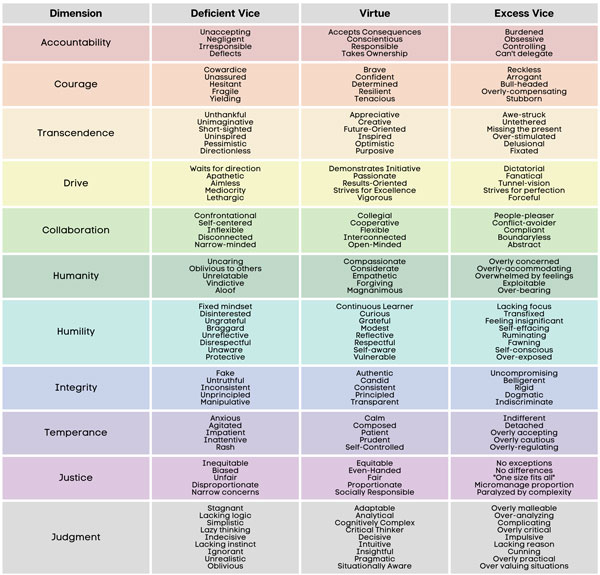
Although most organizations are aligned in the type of culture or values they aim to enhance, the way each individual can contribute may differ. For example, one individual may have underdeveloped integrity and would benefit from strengthening behaviors associated with integrity, such as authenticity and transparency. Another individual may have strong integrity that is turning into dogmatic behavior because they haven’t cultivated other behaviors to support it, such as being open-minded.
The Virtuosity app (see Figure 3) draws on the Oxford Character Project and the Program for Leadership and Character at Wake Forest University’s seven strategies for character development that includes language, reflection, habituation, reminders, exemplars, friendships, and systems.11 It begins by asking the learner to reflect on their own character, after which they are given a set of insights to help them see how their character supports and inhibits their judgment and decision-making. Based on these insights, the learner is encouraged to focus on their weaker behaviors so they can better support their strengths. The learner chooses one character behavior to focus on each week and is given a lesson, daily exercises, and reflection prompts designed to strengthen it. It also encourages the learner to engage in their journey with a partner and to draw inspiration from a wide array of stories, film, art, and more.
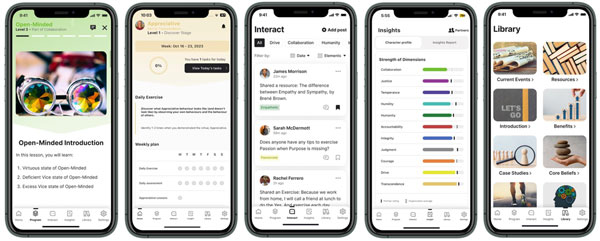
Breadth: Multilevel Alignment Between Individuals & Organization
You do not rise to the level of your goals. You fall to the level of your systems.
— James Clear, habit formation expert12
Translating individual character strength into a culture of character is both simple and complex. The simplicity is that organizations are a reflection of the character of the individuals in it, so efforts to develop individual character manifest in changes to the whole. The complexity is that individual character development is affected by the systems that support or undermine it.
A key task is to pair individual development with changes at the organization level. We see individuals and organizational systems as having a mutually beneficial, self-reinforcing cycle. Individual character development creates stronger organizational systems that create more conducive environments to further support the character development of the individuals in the organization.
The Virtuosity app can certainly be placed in the hands of every individual within an organization, but this is not enough. When organizational practices do not align and support bottom-up initiatives, we see them fall flat or, worse, become another leadership Flavor of the Month.
It’s important to remember that selecting on character as well as competence is not simply an intellectual exercise. Rather, it rests on the individuals doing the selection actively working on their own character development. Embedding leader character into organizational practices like risk management, culture change, and DEI will not be realized without significant investment in character development.
Dr. Luna Wang, a researcher for the Oxford Character Project team, refers to the example of growing watermelons in a box to exemplify the intimate relationship between individual and system.13 People who sold watermelons started growing them in boxes because they were easier to transport and sell.
Although watermelons typically grow in circular fashion, they grew in the shape of the box they were placed within. This is not unlike the systems created by organizations that guide the growth of individuals. And although thinking of systems in a boxlike structure may sound restraining, the habit literature shows us that structured discipline and routine enable us to flourish and give us the extensive breadth of choice. Similarly, organizational systems have the potential (not often realized) to create environments conducive to flourishing.
Far from denying the play of freedom and human agency, the discipline of culture, by relieving us of the cognitive burden of inventing new solutions for every contingency, of having to make choices for every fork in our existential pathways, of having to decide anew the fundamental values that should inform our choices, and of having to make up the norms for organized living, enables us to create, in our social and individual beings, the wildest thoughts and feelings our imaginations allow and the selves we choose to actualize. The more, and the better, the collective constructions of culture work for us, the freer are we, as individuals, to be, to do, and to think as we please.
— Orlando Patterson14
Although the Virtuosity app raises important awareness about the alignment between individual and organizational systems, it takes considerable insight to connect the two in practice to change systems (e.g., selection or performance management) or to embed character into key initiatives (e.g., risk management, culture, strategy, and DEI).
Organizational Implementation
Breadth of implementation involves promoting awareness across the organization at scale; depth of implementation transforms individual character strength into an organizational culture of character. It’s important to advance along both axes to achieve competitive advantage. Figure 4 shows a strategic embedding process model that leverages Virtuosity alongside subject-matter expertise to move beyond temporary bumps. The figure shows the cyclical relationship between character awareness and development displayed on the bottom, which reinforces the systems-level processes displayed on the top. In the middle, the figure shows which people are involved in the process during that stage.
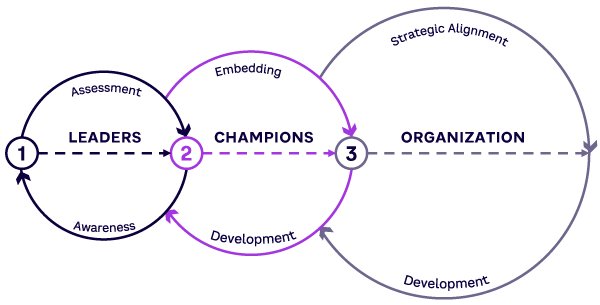
We want to be clear that the function of Figure 4 is to support the implementation of character across an entire organization to fulfill that middle strategic vector. It leaves plenty of room for individuals interested in beginning their own character development journey, regardless of their organization’s aims. As Gandhi famously reminded us: “Be the change you want to see in the world.” Hopefully, as individuals lean into the possibility of understanding and developing leader character, we will begin to realize the benefits of elevating character alongside competence in education, organizations, and society.
The first stage in the process includes understanding what character is, why it matters, and what it looks like within an organization. We suggest leaders are best suited for this first stage because this structural support ensures the character initiative can keep moving forward. If you are reading this and don’t feel your role fits this leader description, we strongly suggest you look for leadership support to bring your character initiative forward within your team or organization.
The second stage establishes the importance of character champions within an organization and involves personal character development that simultaneously enables the embedding of practices conducive for character development. Character champions play a pivotal role in gaining executive support by demonstrating the importance of character and the role it can play to shift organizational aims, whether it be risk management, DEI, culture, or something else.
The second stage equips character champions to effectively roll out character to the organization by creating a conducive environment powered by a character development program. This step is ideally supported by a one-year program in which champions simultaneously focus on the development of their character and regularly discuss strategies they can implement that create support for character development.
We typically begin a program with an exercise titled “Your story yet to be written” that allows the character champions to imagine where they want their organization to be and the role they can play in manifesting it. Then we discuss how the daily exercise of character is needed to achieve this, supported by systems conducive to these changes.
We used this exercise with a National Hockey League team, and it became clear to them that they needed to strengthen their humility and accountability to be the team they wanted to be. This was followed by discussion of what they could do as a team to support that goal.
The final stage scales character development across the organization while creating a strategic alignment that fuels character development. Character champions initiate the rollout of character-based practices and continue to play a pivotal role to enable strategic alignment and the development of individuals. At this stage, it’s important to rely on the leadership support to ensure strategic alignment to foster individual development. Otherwise, you risk the initiative falling flat under the Flavor of the Month category.
Conclusion
With the case for character established, we can think of no more important initiative than to equip individuals and organizations with a way to develop the strength of character needed to address today’s pressing problems. We believe the understanding, tools, and resources are all in place to move from initiatives that produce only a temporary bump of awareness to the strategic impact we collectively seek and need.
References
1 “Leading with Character: A Conversation with John Ossowski, President of the CBSA.” Question of Character podcast, Episode 12. YouTube, accessed December 2023.
2 Crossan, Corey. “Building a Model for Leader Character Development in Sport.” PhD diss., Western University Graduate & Postdoctoral Studies, 2022.
3 Crossan, Mary, et al. “Toward a Framework of Leader Character in Organizations.” Journal of Management Studies, 23 December 2016.
4 Monzani, Lucas, Gerard Seijts, and Mary Crossan. “Character Matters: The Network Structure of Leader Character and Its Relation to Follower Positive Outcomes.” PLoS One, September 2021.
5 Crossan et al. (see 3).
6 Crossan, Mary, and Bill Furlong. Question of Character podcast, accessed December 2023.
7 Crossan, Mary, Gerard Seijts, and Jeffrey Gandz. Developing Leadership Character. Routledge, 2015.
8 Crossan, Mary, Gerard Seijts, and Bill Furlong. The Character Compass: Transforming Leadership for the 21st Century. Routledge, 2023.
9 “Leader Character Insight Assessment (LCIA).” Sigma Assessment Systems, 2013.
10 Crossan, Corey, and Mary Crossan. “The Practice of Developing Leader Character to Elevate Judgment.” In Leadership and Virtues: Understanding and Practicing Good Leadership, edited by Toby P. Newstead and Ronald E. Riggio, 2023.
11 Lamb, Michael, Jonathan Brant, and Edward Brooks. “How Is Virtue Cultivated? Seven Strategies for Postgraduate Character Development.” Journal of Character Education, No. 1, 2021.
12 Clear, James. Atomic Habits: An Easy & Proven Way to Build Good Habits & Break Bad Ones. Random House Business Books, 2015.
13 “A New Generation of Wise Thinkers and Good Leaders.” The Oxford Character Project, accessed December 2023.
14 Patterson, Orlando. “Making Sense of Culture.” Annual Review of Sociology, Vol. 40, July 2014.





